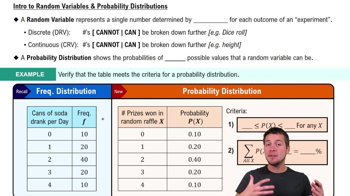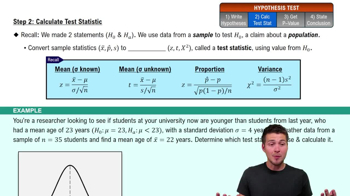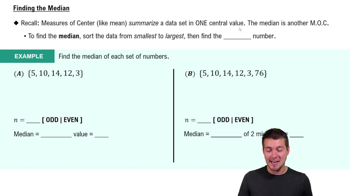No Variation in a Sample An experiment was conducted to test the effects of alcohol. Researchers measured the breath alcohol levels for a treatment group of people who drank ethanol and another group given a placebo. The results are given below (based on data from “Effects of Alcohol Intoxication on Risk Taking, Strategy, and Error Rate in Visuomotor Performance,” by Streufert et al., Journal of Applied Psychology, Vol. 77, No. 4). Use a 0.05 significance level to test the claim that the two sample groups come from populations with the same mean.
Table of contents
- 1. Intro to Stats and Collecting Data1h 14m
- 2. Describing Data with Tables and Graphs1h 55m
- 3. Describing Data Numerically2h 5m
- 4. Probability2h 16m
- 5. Binomial Distribution & Discrete Random Variables3h 6m
- 6. Normal Distribution and Continuous Random Variables2h 11m
- 7. Sampling Distributions & Confidence Intervals: Mean3h 23m
- Sampling Distribution of the Sample Mean and Central Limit Theorem19m
- Distribution of Sample Mean - Excel23m
- Introduction to Confidence Intervals15m
- Confidence Intervals for Population Mean1h 18m
- Determining the Minimum Sample Size Required12m
- Finding Probabilities and T Critical Values - Excel28m
- Confidence Intervals for Population Means - Excel25m
- 8. Sampling Distributions & Confidence Intervals: Proportion1h 12m
- 9. Hypothesis Testing for One Sample3h 29m
- 10. Hypothesis Testing for Two Samples4h 50m
- Two Proportions1h 13m
- Two Proportions Hypothesis Test - Excel28m
- Two Means - Unknown, Unequal Variance1h 3m
- Two Means - Unknown Variances Hypothesis Test - Excel12m
- Two Means - Unknown, Equal Variance15m
- Two Means - Unknown, Equal Variances Hypothesis Test - Excel9m
- Two Means - Known Variance12m
- Two Means - Sigma Known Hypothesis Test - Excel21m
- Two Means - Matched Pairs (Dependent Samples)42m
- Matched Pairs Hypothesis Test - Excel12m
- 11. Correlation1h 6m
- 12. Regression1h 50m
- 13. Chi-Square Tests & Goodness of Fit1h 57m
- 14. ANOVA1h 57m
9. Hypothesis Testing for One Sample
Steps in Hypothesis Testing
Problem 9.5.4
Textbook Question
Randomization vs t Test Two samples of commute times from Boston and New York are randomly selected and it is found that the samples sizes are n1 = 18 and n2 = 12 and each of the two samples appears to be from a population with a distribution that is dramatically far from normal. Which method is more likely to yield better results for testing Mu1 is not equals to Mu2. Hypothesis test using the t distribution (as in Section 9-2) or the resampling method?
 Verified step by step guidance
Verified step by step guidance1
Step 1: Understand the problem. The goal is to determine which method is more appropriate for testing the hypothesis that the population means (μ₁ and μ₂) of commute times for Boston and New York are not equal, given that the sample sizes are n₁ = 18 and n₂ = 12, and the population distributions are far from normal.
Step 2: Recall the assumptions of the t-test. The t-test assumes that the data comes from a normal distribution or that the sample sizes are sufficiently large for the Central Limit Theorem to apply. Since the population distributions are dramatically far from normal and the sample sizes are relatively small (n₁ = 18 and n₂ = 12), the t-test may not yield reliable results.
Step 3: Consider the resampling method. Resampling methods, such as bootstrapping or permutation tests, do not rely on the assumption of normality. These methods involve repeatedly sampling from the observed data to create a sampling distribution, making them more robust for non-normal data.
Step 4: Compare the two methods. Given the small sample sizes and the non-normality of the population distributions, the resampling method is likely to yield better results because it does not depend on the normality assumption and can handle small sample sizes effectively.
Step 5: Conclude the reasoning. Based on the information provided, the resampling method is more appropriate for testing the hypothesis that μ₁ ≠ μ₂ under these conditions. The t-test is less suitable due to the violation of its assumptions.
 Verified video answer for a similar problem:
Verified video answer for a similar problem:This video solution was recommended by our tutors as helpful for the problem above
Video duration:
2mPlay a video:
Was this helpful?
Key Concepts
Here are the essential concepts you must grasp in order to answer the question correctly.
Randomization
Randomization is a fundamental principle in statistics that involves randomly assigning subjects to different groups to eliminate bias and ensure that the groups are comparable. This method helps in making valid inferences about the population from which the samples are drawn. In the context of hypothesis testing, randomization can enhance the reliability of results, especially when dealing with non-normal distributions.
Recommended video:
Guided course

Intro to Random Variables & Probability Distributions
t Test
The t Test is a statistical method used to determine if there is a significant difference between the means of two groups. It assumes that the data is normally distributed and is particularly useful when sample sizes are small. However, when the underlying population distributions are not normal, the t Test may yield unreliable results, making it essential to consider alternative methods.
Recommended video:
Guided course

Step 2: Calculate Test Statistic
Resampling Method
The resampling method, including techniques like bootstrapping, involves repeatedly drawing samples from the observed data to estimate the sampling distribution of a statistic. This approach is particularly useful when the assumptions of traditional parametric tests, such as normality, are violated. Resampling can provide more accurate confidence intervals and hypothesis tests, especially in cases with small sample sizes or non-normal distributions.
Recommended video:
Guided course

Calculating the Median

 6:21m
6:21mWatch next
Master Step 1: Write Hypotheses with a bite sized video explanation from Patrick
Start learningRelated Videos
Related Practice
Textbook Question
